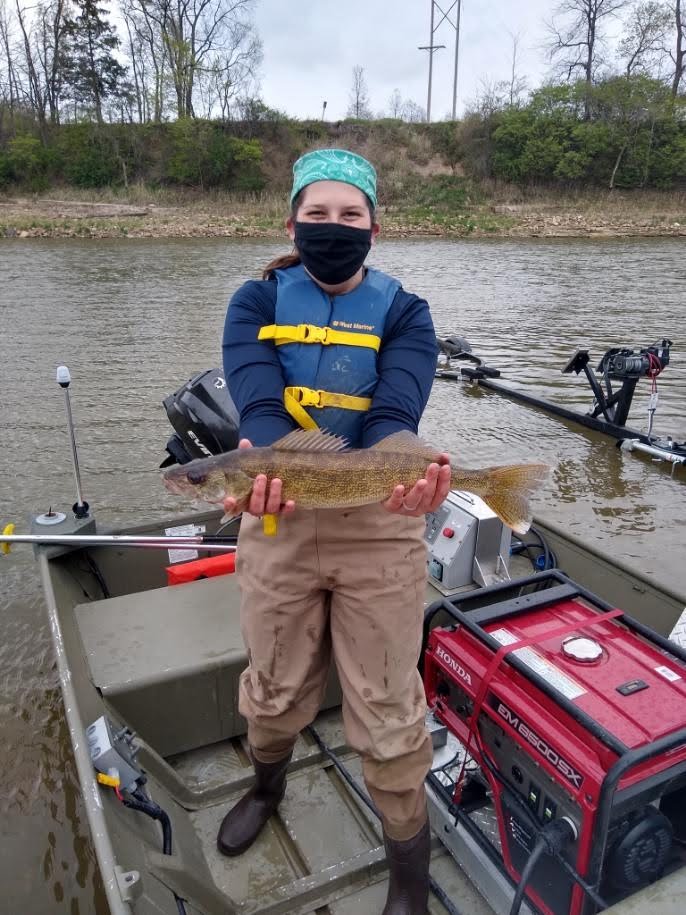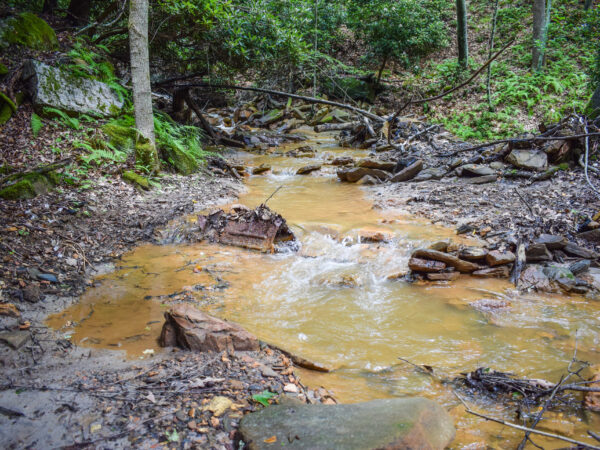
For more than a century, a dam divided the upstream Sandusky River from Lake Erie. People got power, but fish were prevented from reaching native spawning grounds.
Then, four years ago, the dam came down, like hundreds around the Great Lakes region. It had been replaced as a power source years earlier, and environmentalists argued to restore the river’s natural course.
Now, some results are in about the impact of the un-damming. From native species to invasive species, fish behavior to anglers’ takes, the effect of the removal is measured and judged.

University of Toledo graduate student Taylor Sasak displays a Sandusky River walleye. (Photo courtesy of ODNR)
For example, research conducted by a University of Toledo graduate student shows that at least two species of fish, walleye and white bass, are beginning to make use of new spawning habitat upstream from the site where the Ballville Dam divided the river for 107 years.
But the new activity has been at a slower pace than biologists had expected. And the “new” Sandusky River gets mostly good reviews from residents, though some say fishing in the area where the dam was just isn’t as good as it used to be.
It Starts with History
The dam, originally constructed by the Ohio Power Company in 1913 to produce hydroelectricity stretched about 420 feet from bank to bank and stood about 35 feet tall. It was purchased by the City of Fremont in 1959, and its reservoir was tapped as a city water supply.
In 2013, after a years-long design and construction process including contentious cost-overruns, missteps and litigation, the city opened a new reservoir nearby to serve as a drinking water supply. The dam had long since been decommissioned as an electricity producer. Deterioration and maintenance costs, in addition to creating more spawning grounds, were cited among reasons to raze the dam.
Great Lakes Now covered the Boardman River dam removal in this September 2020 segment:
While studies and preparations for the dam removal took years, the removal itself was quick. In just about 20 working days in 2018 a crew using six excavators demolished the dam in stages, allowing for some water to flow through, then more, then all after a first notch was cut a year earlier.
In total about 10,000 cubic yards of concrete was excavated and crushed then used as material to create embankments. Additionally, more than 29,000 cubic yards of a century’s worth of accumulated sediment was utilized as embankment material in the area of the dam, then staked with native plants and trees.
The removal opened 22 river miles to the Sandusky River’s natural flow.
More River, More Fish
Environmentalists and anglers are big fans of removing dams from rivers and streams and allowing them to return to free-flowing bodies of water. Especially in cases where migratory fish utilize them for spawning. Walleye and white bass, for example, leave Lake Erie each spring to spawn in the shallow waters of the Maumee River in Toledo and the Sandusky River in Fremont.
In fact, the two rivers provide a huge recreational opportunity for tens of thousands of anglers to wade and bank fish for the two species. Each spring when water temperatures are just right and there’s enough water flow for the fish to swim upstream into its shallower reaches the rivers are teeming with fish and anglers.
In Fremont, anglers had been limited by Ohio Department of Natural Resources (ODNR) regulations to fishing the river up to the downtown Fremont area, about a mile or so below the dam. After the removal, the entire river was opened to anglers, who have since made the most of it.
“The walleye fishing has definitely been good in the newly opened area, but I’m not aware of it being great,” said Travis Hartman, the ODNR’s Lake Erie fisheries program administrator.
Hartman said the dam’s removal doesn’t necessarily mean more walleye would enter the river from the lake to spawn right away. But, he said, since some fish were born there, they’ll return to spawn at the site each spring and will spread out, utilizing more of the newly opened section of river to take care of essential business. The dam’s removal opened up walleye habitat and walleye fishing access all the way to the next dam, in Tiffin.
“I think eventually you’ll have more fish returning to the river to spawn because of good hatches in the river,” Hartman said. “And probably one of the least-publicized things about that dam coming out is that when it did you immediately start seeing improved habitat below the dam because gravel and stone are moving downstream filling in all those starved areas that were bedrock. All along we expected an improvement to the existing habitat areas, plus you’re adding the potential to add spawning habitat above the dam.”
Hartman said biologists weren’t certain what the timeline would look like, but that other than a slow start for the walleye, the dam’s removal has been a success.
Tag, You’re It
During the spring 2019 walleye spawn on the river, anglers eagerly made their way upstream of the old dam site to fish. And they caught walleye in the newly opened spawning grounds.
Matt Faust, an ODNR fisheries biologist who spends time tracking tagged fish, said so far, no tagged walleye have been located above the old dam site.
“We still haven’t detected any up there,” he said. “We have receivers probably several river miles upstream from the old dam site, so it’s possible some of them popped up but were never detected.”
Biologists have deployed numerous receivers in the Sandusky River to track movements of fish fitted with tiny devices detected electronically when they swim near a receiver, allowing the fish’ movements to be followed.
But some of the walleye tags are getting old, Faust said, having been placed on fish during spring spawning in the Sandusky River in 2014, 2015 and in 2018. Some 100 each year were tagged.
Other tagged fish including redhorse suckers, channel catfish and white bass, all native species, which have been detected upstream of the site. And Faust said that’s good, since it means those fish are making use of their new freedom.
Some tagged fish are invasive species, like grass carp.
The voracious herbivores were originally imported from Asia to control vegetation at aquaculture sites. Through flooding events, they escaped into the Mississippi River Basin and have since spread widely.
Tagged grass carp have been detected in and are believed to actively spawn in Sandusky Bay and the river. Those fish, according to Faust, are the target of ODNR studies, including how to prevent them from moving upstream.
“The one good thing is we’ve not detected any of the tagged grass carp moving up there because that was a concern,” he said. “Opening up more river could potentially increase recruitment of those, make it easier for them to spawn successfully. So it’s a good thing we haven’t detected any so far.”
Urgin’ for Sturgeon?
In spring 2019 Jamie Ball was fishing around Wolf Creek Park, a few miles upstream from the former dam site. The professed smallmouth angler said he doesn’t enjoy the “shoulder-to-shoulder thing” that walleye anglers who are wading do during the spring run so he was upstream, alone. He’d already lost a few jigs on snags that day and was performing his usual conservation ritual.
“Wherever I go I carry a bag and end up taking out a load of trash,” he explained. “I was getting snags, so when I was reeling in I figured I’d snagged, so I didn’t set the hook on it.”
He described the log he hooked as really big, and ugly – and he eventually realized it was not a log. And it wasn’t a giant catfish, either.
He’d snagged, on the top of its head, a lake sturgeon.
“There was no hope in hell,” he said. “That fish was going to do whatever it wanted to do and there was nothing I could have done about it.”
After his Cherrywood rod bent double, the affair lasted about a minute before the fish rolled, broke the line and disappeared. Ball estimated the fish at three to four feet in length. He reported it to the ODNR, which investigated and deemed the account credible – and cool. It was the first known sturgeon upstream of the dam site in ages.
“It’s probably been 150 years,” said Mike Wilkerson, an ODNR fisheries supervisor. “If you go back and look at the records, different dams were up on the river in different places from the mid-1800s.”
The Dam Trend
According to American Rivers, a conservation and advocacy non-profit based in Washington D.C., more than 1,950 dams have been removed in the nation since 1912, with an overwhelming percentage of those taking place in the last three decades.
Close to half of those, 42 percent, were in Great Lakes states. Of the 825 dams removed in those eight states, 697 were removed in just four states: Pennsylvania, Wisconsin, Michigan and Ohio.

Lisa Hollingsworth-Segedy, director of river restoration at American Rivers. (Photo courtesy of American Rivers)
“We have been working to make dam removals business as usual,” said Lisa Hollingsworth-Segedy, director of river restoration with American Rivers. “The fact is there’s more money available to remove dams than there is to repair or replace them.”
Removing dams usually costs significantly less than repairing or replacing them, according to Hollingsworth-Segedy. Such was the case in Fremont. Estimates were placed at about $27 million to repair and bring the structure up to current standards while a complete removal price tag came in at about $12 million.
In most cases, she said, public opposition to dam removals is grounded in tradition.
“People have grown up with a dam on their river and maybe it’s the place where they learned to fish or swim, maybe they proposed to their sweetheart or had wedding pictures made. We have a lot of attachment to what we know in our community and as humans we’re averse to change,” Hollingsworth-Segedy said. “People have felt like once you remove their dam the river’s going to go away or there will be only a stinky mudhole left or the fish will never return.”
In reality fish do return, and sometimes there are surprises, such as a California dam that was removed in part so that steelhead salmon could move upstream to spawn. Biologists there quickly realized that coho salmon, a fish never recorded spawning in the river, showed up also.
“In Pennsylvania I’ve done some dam removals where we get the equipment out of the stream and turn everything off and it gets nice and quiet and you can stand on the bank and within 10 or 15 minutes you can see the first fish start to move through. It just gives you chills.”
The Study of Molluscs
Other species, like freshwater mussels, must get new digs when dams fall
“When a dam gets removed you have to have a certified malacologist and you have to have enough people so that when the water drops you can get those mussels quick enough (and) they’re not going to get too warm or too exposed,” explained John Navarro, aquatic stewardship program administrator with the ODNR. “And usually you move them upstream instead of downstream.”
Downstream water contains too much sediment from newly released water, he explained, so mussels get a fresh start upstream. And that takes a lot of manpower.

Professor Michael Hoggarth, aqautic ecologist at Otterbein University. (Photo courtesy of Otterbein University)
In this case, it was student power in the form of more than two dozen from northern Ohio schools, both undergraduate and graduate students, supervised by Otterbein University’s professor Michael Hoggarth, an aquatic ecologist and a freshwater mussels expert.
Over a period of several days in summer 2017, after the initial water-relieving notch in the dam was made, the students moved hundreds of five-gallon buckets filled with native mussels. In total, there were more than 11,000 mussels representing 14 native species moved. Those included species like the giant floater, paper pondshell, purple wartyback, mucket, plain pocketbook, round pigtoe and creeper, among others.
“They can’t just move themselves,” Hoggarth said of the many mussels located in the pool waters above the dam. “They’d put their foot out and move toward their foot and make these little trails in the sand and essentially just go in circles.”
Volunteers collected some species as large as salad plates and weighing a pound or more during the dam’s demolition. All were relocated upstream to pools which offered a similar habitat to the location where they were found.
“Now those mussels that were upstream of the dam have access to go down through the rest of the Sandusky River into Sandusky Bay, and the mussels that are in the bay now can move up into this area,” Hoggarth said.
The method mussels use to populate a stream, since some spend their entire lives in an area no larger than a square meter, is by utilizing fish to transport their tiny young, called glochidia, Navarro explained. Mussels disperse their hundreds or thousands of offspring onto fish, which then transport the tiny creatures, which begin growing their shells while attached to fish’ gills, to other parts of a lake or stream. Eventually they drop off, making themselves at home on the bottom.
A Little Bad, A Lot of Good
Brian Karlovetz lives outside Fremont and had been fishing at the dam for years. He’s not impressed with the quality since the dam came down.
“In the summer I’d be down there all day long and I’d catch all kinds of stuff,” he explained. “There were people that would pull in stringers of catfish and bullheads.”
That’s not the case now, though. Karlovetz said taking out the dam was a mistake, so far as local fishing goes.
“The dam had been there for a really long time, and it had created a lot of different habitat for stuff, and the fishing was just great,” he said. “I even caught a black bullhead once and I’d never seen anything like it.”

The first notch is cut in the Ballville Dam in July, 2018. (Photo Credit: James Proffitt)
Catching fish, other than walleye and white bass during the spawn, is the exception and not the rule now, according to Karlovetz.
“I’ve been down there three or four times since then and it looks like it would be a great fishing, like for smallmouth bass, but I haven’t caught anything – not a single thing since they’ve taken the dam out,” he said. “I’ve seen a lot of people down there and I’ve just never seen anyone catching anything, so I don’t know whether they have.”
Although Karlovetz bemoaned the dam removal’s overall effect on fishing, there is an upside.
“I know the walleye have been moving up through the river,” he said. “And it looks really nice. They claim the river will return to its natural state, which I’m sure it will.”
Hollingsworth-Segedy said rivers often tend to heal themselves with little additional work beyond a dam removal. That appears to be the case on the Sandusky.
“Afterward, people realize ‘Maybe I like the river the way it is now, too,’” she said. “That’s on people like me to be able to draw a picture and show people who are against dam removal that yes, you are giving something up but you’re going to get something that’s much more valuable in return.”
Catch more news at Great Lakes Now:
Uncertainty for Michigan rivers, residents as Consumers reconsiders its 13 dams
Weighted Walleye: The fallout of the Lake Erie fishing tournament
Featured image: A current view of the site where the Ballville Dam stood for more than a century. (Photo Credit: James Proffitt)




